Full Length Research Paper
ABSTRACT
A nickel vanadyl molecularly imprinted nanofiber (NVMIN) was developed by the electrospinning technique, employing polyethylene terephthalate (PET) and linear polyethylenimine (L-PEI) as the matrix polymers, nickel tetraphenylporphyrin (NTPP) and vanadyl tetraphenylporphyrin (VTPP) as the mixed-template molecules. The fabricated NVMIN was evaluated as a sorbent for the removal of NTPP and VTPP from organic media. The effects of trifluoroacetic acid (TFA), dichloromethane (DCM), dimethyl sulphoxide (DMSO), pentane (PEN) on electro-spinnability of the PET/L-PEI solutions and the morphological appearance of the PET/L-PEI fibers were investigated qualitatively by means of a scanning electron microscope (SEM). Electrospinning of 14 to 30% w/v PET/L-PEI solutions in TFA produced beaded and smooth fibers, depending on the concentration range. The addition of DCM and PEN as modifiers helped improve the electrospinnability, with PEN being the best, while the addition of DMSO made the solutions not spinnable. The results indicated that the NVMIN showed higher affinity (99% higher) for NTPP than the non-imprinted nanofiber (NIN) indicating that the NVMIN contained a lot of specific binding sites. It was determined that the NVMIN exhibited the same selectivity specialism for both NTPP and VTPP. However, the interaction strength was strongly dependant on the type of solvent, where the strongest interaction was achieved in chloroform. In addition, the thermodynamic parameters calculated from the adsorption data suggested that the adsorption of NTPP onto NVMIN was a spontaneous and exothermic process.
Key words: Electrospinning, mixed-templates, adsorption, demetallation, solvents.
INTRODUCTION
The global increase in unconventional crude oil resources in recent years has resulted in increasing quantities of sour crudes, acidic crudes, or extra heavy crudes being produced (Zhang, 2002). These crude oils contain a large variety of metal compounds with vanadium and nickel being the major metals. For example, Cantarell crude oil contains more than 243 µg/g vanadium and nickel, Tahe crude oil has more than 400 µg/g, and Bolivar Coastal crude oil from Lake Maracaibo, Venezuela also has excess of 1200 µg/g of these metals (Xuet al., 2001).
Nickel and vanadium are present in heavy oils, forming porphyrinic structures, and they pose a particular problem for refineries as the metals accumulate as contaminants on catalysts, where they cause permanent deactivation of both desulfurization and cracking catalysts, resulting in serious economic losses (Ware et al., 1985; Welter et al., 2009; Dechainet al., 2010; Nakamotoet al., 2004). In addition, both nickel and vanadium promote dehydrogenation reactions during cracking sequence, which result in an increase in the amounts of coke and dry gas, thus leading to a decrease in gasoline production (Li, 2001). Therefore, refining such crude oils is a significant challenge for petrochemical processing. Most inorganic metals in crude oil can be removed by electric desalting, but vanadium and nickel organic compounds are oil-soluble and cannot be removed by this method (Xuet al., 2001).
Several techniques have been utilized for the removal of nickel and vanadium from crude oils (Reynolds, 2004). Among these techniques, chemical processes have been commonly used because of their effectiveness; these include hydro-demetallization (Long et al., 2003) and solvent extraction (Mohammed et al., 2006). However, the removal of metal by hydrogenation requires high capital investment and the catalysts for the process are difficult to regenerate, therefore affecting the disposal of waste catalysts. Solvent extraction is suitable only for residues containing the high bitumen content, and its capital and operational costs are high (Shuangchenget al., 2011). Because of these limitations, much better technologies have to be considered.
Molecular imprinting technology (MIT) is a dynamic methodology used to design polymeric receptors against a wide range of target molecules. It was first reported in 1949 by adsorbing different dyes in silica (Mosbach, 2006; Alexander et al., 2006). Originally, it was introduced as a means to create binding sites in synthetic polymers. The technique has now matured and has become established in several disciplines owing to its ability to form stable, robust materials with molecular selectivity for a wide variety of compounds. MIT is based on the formation of a complex between an analyte (template) and a functional monomer. In the presence of a large excess of a cross-linking agent, a three-dimensional polymer network (Ramstrom et al., 1999) is formed. Removal of the template from the formed polymer liberates binding sites with selectivity toward the template molecule. In most of the accounts of MIT, a single template molecule is used to create the specific binding site of the imprinted polymer (MIP). However, the imprinting process does not have to be limited to a single template, and several compounds can be imprinted simultaneously (Scheme 1). Advantages of multiple-template imprinting are that several different classes of compounds can be extracted, separated, assayed, detected, or otherwise analyzed at one time (Schweitz et al., 2002; Spegel et al., 2003; Sreenivasan et al., 2007; Suedee et al., 2004). A few examples have been reported on different MIP polymers or polymer mixtures that have been imprinted with more than one template. The first example was reported by Sreenivasan and Sivakumar (Sreenivasan et al., 1999), who imprinted both salicylic acid and hydrocortisone in the same MIP formulated with hydroxyethylmethacrylate (HEMA) as the functional monomer and ethylene glycol dimethacrylate (EGDMA) as the crosslinker. Dickert et al. (2001) described the idea of double “molecular imprinting” using two templates that were simultaneously imprinted in a crosslinked polyurethane thin film.
Although MIPs with multiple templates might have been prepared by many researchers, to the best of our knowledge, there is still no published report with respect to the preparation of multiple templates imprinted nanofibers and their application in organic media.
In this study, we sought for a wider selection of solvent systems and utilized the versatile electrospinning technique to fabricate nickel vanadyl molecular imprinted nanofibers (NVMIN), in which functional macromolecules poly(ethyleneterephthalate) (PET) and linear-polyethylenimine (L-PEI) were chosen as matrix polymers, styrene was used as a functional monomer, divinyl benzene as cross-linker, nickel tetraphenyporphyrin (NTPP) and vanadyltetraphenylporphyrin (VTPP) as template molecules (Figure 1). The fabricated NVMIN showed preponderant adsorption capacity and selectivity compared to non-imprinted nanofibers (NIN). The prominent performance of the NVMIN illustrated its potential as a flexible, variable and selective sorbent that is well suited for handling trace metals in organic media.
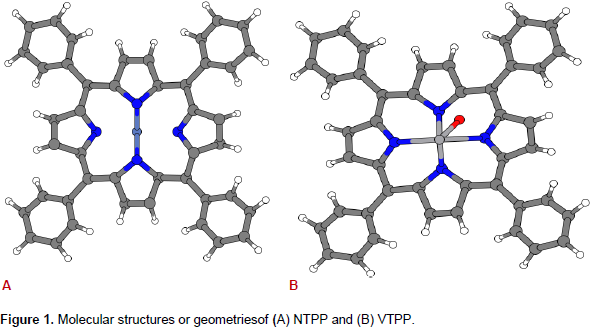
METHODOLOGY
Chemicals
Linear-polyethylenimine with Mw of 250000 g/mol was purchased from PolySciences Inc. (Warrington, PA). Styrene, divinyl benzene (DVB), nickel tetraphenylporphyrin, vanadyltetraphenylporphyrin, 1,1 azobis(cyclohexanecarbonitrile)(ACC), chloroform, methanol (MeOH), poly(ethylene terephthalate), trifluoroacetic acid (TFA), dichloromethane (DCM), dimethyl sulphoxide (DMSO), pentane (PEN) and acetic acid were supplied by Sigma-Aldrich (Johannesburg, South Africa) and used as obtained. All the chemicals used were of analytical grade. The properties of these solvent and the modifying liquids are summarized in Table 1.

Preparation of NVMIN solution
The method of nanofiber fabrication as described by Awokoya et al. (2013) was employed for the fabrication of NVMIN fibers. Poly(ethylene terephthalate)/Linear-Polyethylenimine solutions were prepared by adding equal quantities of PET and L-PEI in TFA and some mixed solvent systems of TFA and another solvent or liquid (that is, DMSO, DCM, and PEN) in various compositional ratios. Precisely, the compositional ratios of TFA and DMSO were90:10, 80:20, 70:30, 60:40 and 50:50 v/v, while the compositional ratios of TFA and another liquid (that is, DCM and PEN) were 98:2, 95:5, 93:7 and 90:10 v/v, respectively. The solutions of PET/L-PEI in TFA were prepared in various concentrations ranging from 14 to 30% w/v, whereas those of PET/PEI in mixed solvent system were fixed at the concentration of 22% w/v, with continuous agitation in a closed vial for 5 h at room temperature. The solution of molecularly imprinted polymer containing cross-linker, monomer and the templates in chloroform was blended into PET/PEI solutions and stirred overnight (Scheme 1). Prior to electrospinning, all of the as-prepared solutions were measured for their surface tension, shear viscosity, and electrical conductivity (Table 2) by a KRÅ°SS School Tensiometer K6, a Brookfield Digital viscometer Model DV-I+(at 5.0 RPM), and a Mettler Toledo FE 30/EL 30 conductivity meter, respectively.

Electrospinning process
The resultant homogeneous solution was placed in a 20 ml disposable plastic syringe driven by a piston syringe pump, NE-1000, Farmingdale, (NY, USA). The positive electrode of a high voltage supply was applied to the metal spinneret (0.5 mm) tip of the syringe. The applied voltage used for the electrospinning was 15 kV, and the tip to collector distance was 13 cm. The entrapped template molecules (NTPP and VTPP) were removed from the resultant nanofiber by MeOH and acetic acid (90:10) until no NTPP and VTPP were observed to leach from the fiber using ICP-OES. Figure 2 shows the removal of NTPP and VTPP from the nanofiber in successive batches. The electrospun fiber mat was dried under vacuum at room temperature to remove the trace solvents and kept in a desiccator until analysis. As a control, non-imprinted nanofibers (denoted as NINs) were prepared following the same procedure without NTPP and VTPP as templates.
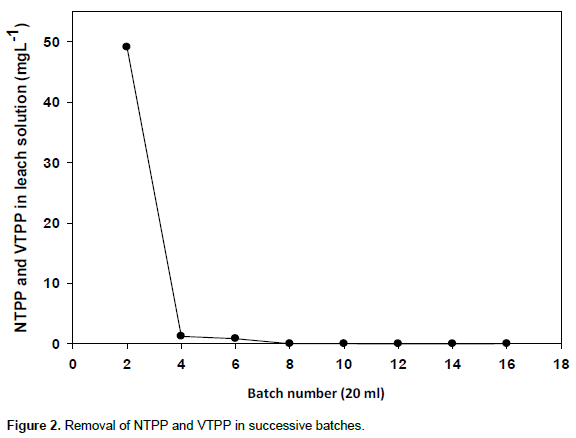
Scanning electron microscopy (SEM)
To determine the surface morphology of the NVMIN and NIN, the nanofiber mats were taken and dusted onto a carbon sticker, then coated with gold using a sputter coater (Balzers Union, FL-9496) for 30 min. Images were recorded using VEGA TESCAN SEM instrument. Energy dispersive X-ray spectroscopy (EDX) (INCAPentaFETx3Oxford ISIS EDS) was used to observe the chemical composition of products.
FT-IR spectroscopy
The Fourier transform infrared (FT-IR) spectra of non-imprinted and molecularly imprinted nanofibers were obtained using a Perkin Elmer Spectrum 100 FT-IR spectrometer with an AutoIMAGE System.
Adsorption experiment
The adsorption experiment was carried out on a mechanical shaker at room temperature by adding an optimal quantity of the washed NVMIN (30 mg) into 20 ml volume of NTPP solution which was prepared in chloroform varied in the concentration of 10 to
50 mg L-1 at 15, 25, and 35°C to study the thermodynamics of adsorption. After shaking for 6 h, NVMINs were centrifuged at 12,000 rpm for 5 min, from which a 15 ml supernatant was collected for the determination of free analyte by ICP-OES. Three replicate extractions and measurements were performed for each solution. The extraction percentage of NTPP was calculated from equation 1:

Where Ci is the initial NTPP concentration (mg L-1), Cf is the NTPP concentration at adsorption equilibrium (mg L-1).
Selectivity of the NVMIN
The selectivity of the NVMIN was conducted by immersing the NVMIN into chloroform solutions containing NTPP and VTPP at room temperature, respectively. The recognition coefficient (α) was used to evaluate the selectivity (Yang et al., 2005) and could be calculated using equation 2:

Where [S]imprinted is the DBT binding amount to the MIP (mg g-1), and [S]non-imprinted is the binding amount to the NIP (mg g-1).
RESULTS AND DISCUSSION
Effects of a single solvent system on the general spinnability characteristics of NVMIN
PET/L-PEI dissolved easily in TFA and formed a clear homogenous solution at room temperature without any precipitates and air bubbles, while in solvents such as DMSO, DCM and PEN PET/L-PEI did not dissolved. The nickel vanadyl PET/L-PEI solutions in pure TFA were prepared at various concentrations ranging from 14% (w/v) to 30% (w/v) to investigate the effect of the solution concentration on morphology of the fibers. As is known, electrospinning is a technique that utilizes the electric force to drive polymer fluid and to produce polymer nanofibers. The shear viscosity, electrical conductivity, and surface tension of the polymer solution are the most important properties affecting the formation of nanofibers (Bhuvanesh et al., 2007).
The increase in solution concentration could adversely affect the cohesiveness of the liquid/air interface, thus leading to the reduction in the surface tension of the solution. On the other hand, both the viscosity and electrical conductivity of the solutions were found to increase. The increase in the solution viscosity could be explained by the fact that the increased polymer mass fraction in the solution led to the increase of the entangled actions of polymer molecule chains, which facilitated the formation of the electrospunnanofibers. The increase in the solution electrical conductivity with increasing solution concentration could be due to hopping of charged species between conducting polymer chains resulting from the dissolution of PET/L-PEI in the acidic condition of the solutions (Schmidt et al., 2012).
The SEM images of electrospunnanofibers with pure TFA are shown in Figure 3. For solution concentration less than 18 %, droplet spray occurred and a continuous jet of polymer, that is spinning was not formed. The jet from low viscosity solutions breaks up into droplets due to the lower amount of polymer and lower entanglement density than that needed to form a stable jet. With solution concentration between 20 and 24% w/v, the presence of beads was observed. However, the beads completely disappeared and the formation of finer and more uniform electrospunfibers were observed as the concentration of the solution was increased to 26, 28 and 30% w/v. It is believed that the combination of the relatively high viscosity of the solution and dielectric constant of the solvent (that is, 8.55, Table 1) improved the morphology of the fiber.
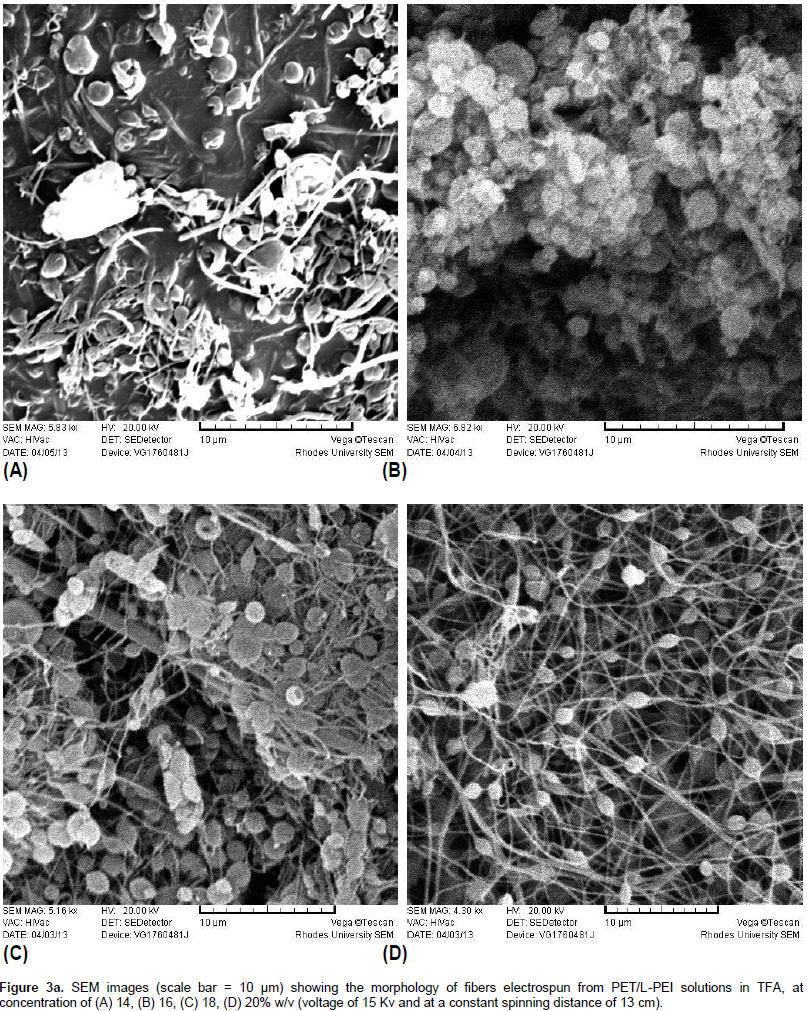
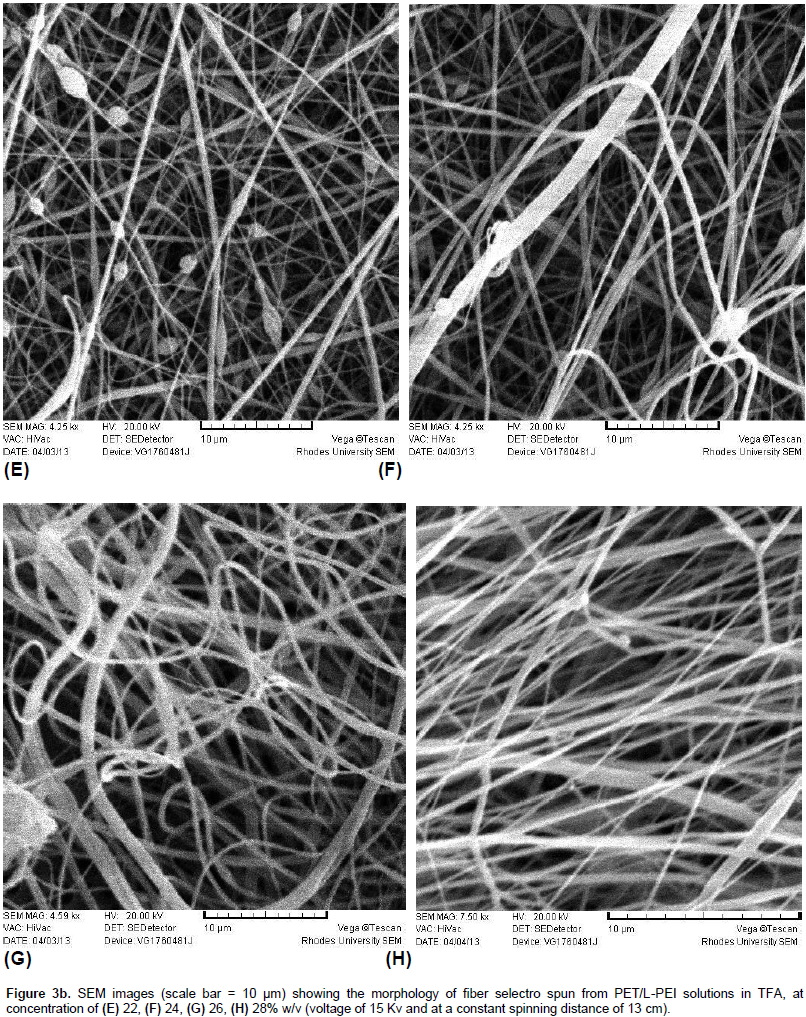
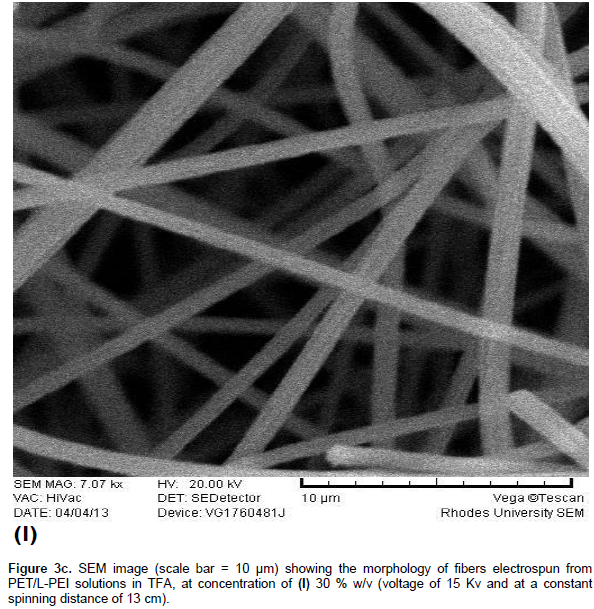
Mixed-solvent systems
The second solvent was mixed with TFA, so as to qualitatively observe the effects of solvents on electrospinnability of the as-prepared PET/L-PEI solutions and the morphological appearance of the obtained PET/L-PEI fibers. Based on the results obtained on the single solvent system, 22% w/v of the PET/L-PEI solution was chosen to further investigate the effect of the mixed-solvent systems because the viscosity of the solution at the particular concentration in TFA was high enough to allow the formation of fibers with less beads. Another important reason for choosing 22% w/v was to observe whether the addition of the second solvent was able to totally suppress the formation of beads.
Trifluoroacetic acid and dimethyl sulphoxide
The morphology of the as-prepared fibers from the PET/L-PEI solutions in mixed solvents of TFA and DMSO are shown in Figure 4. The DMSO was mixed with TFA to produce the mixed solvent at the compositional ratios of 95:5, 93:7, 90:10, and 80:20 v/v (TFA/DMSO), respectively. Judging from the high dielectric constant value (Table 1) of the DMSO solvent, the PET/L-PEI solutions in TFA/DMSO should have been readily spinnable. However, it was not the case, as the solutions were not spinnable in every ratio prepared. It was observed that, upon spinning, the solutions jetted out rather easily, but the ejected streams of the solutions did not form into fibers. The most likely explanation might be as a result of the extremely high boiling point of DMSO (that is, 189°C) that caused the ejected streams to stay in the liquid form even after being collected on a collective target.
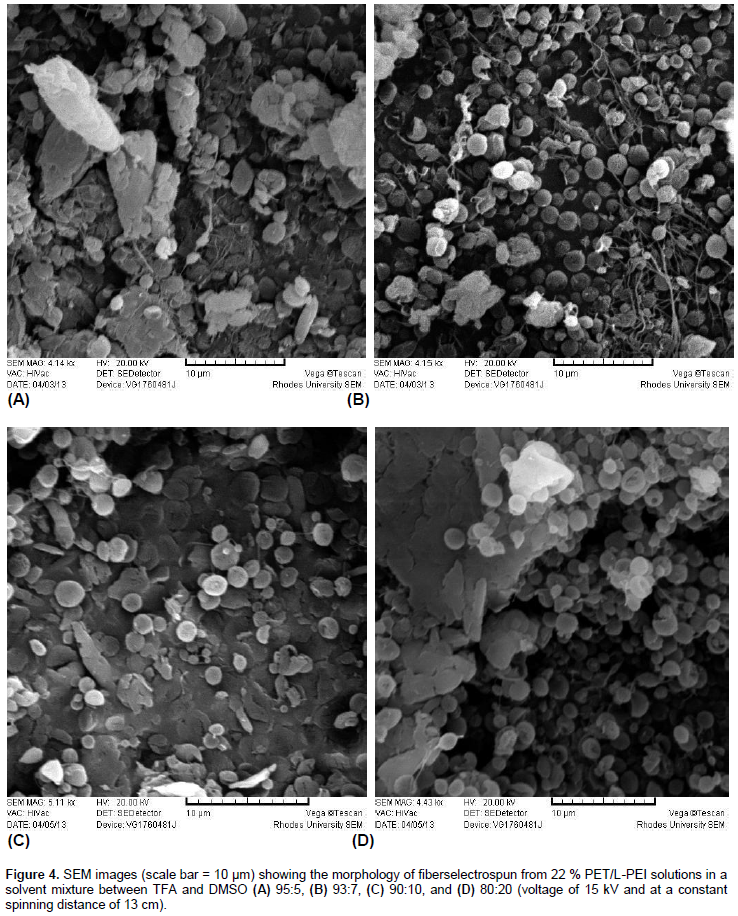
Trifluoroacetic acid and dichloromethane
The morphology of the as-prepared fibers from the PET/L-PEI solutions in mixed solvents of TFA and DCM are shown in Figure 5. The DCM was mixed with TFA to produce the mixed solvent at the compositional ratios of 95:5, 93:7, 90:10, and 80:20 v/v (TFA/DCM), respectively. At 95:5 ratio, a large amount of beaded fiber was obtained. Interestingly, the increase in the quantity of DCM in the solvent mixture increased the thinning of the jet and the fiber formed appeared to be smaller than those from the solution in pure TFA.
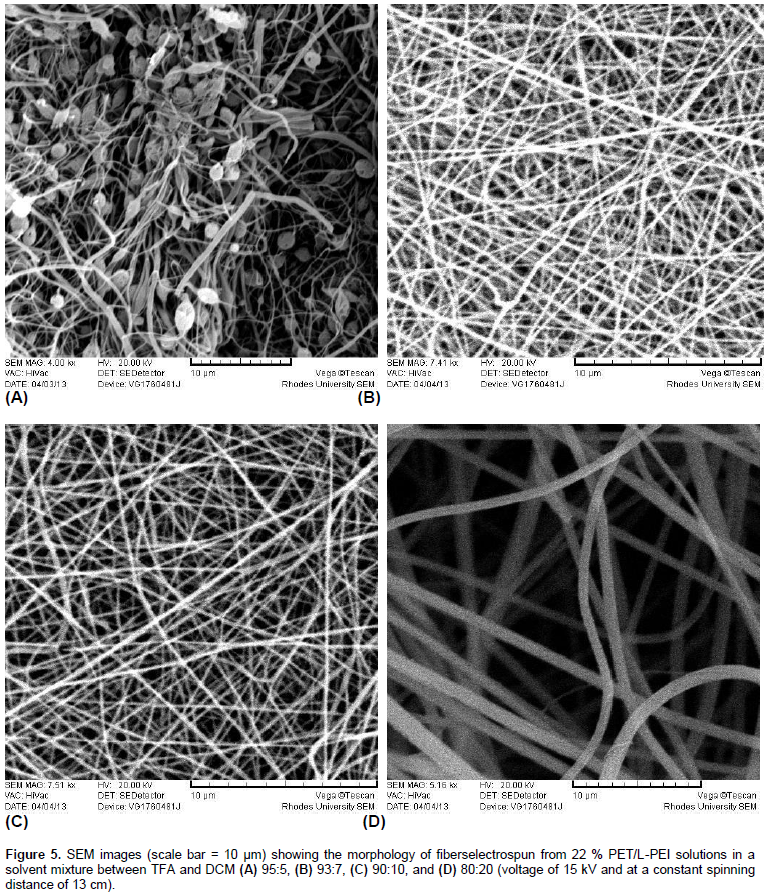
Trifluoroacetic acid and pentane
The morphology of the as-prepared fibers from the PET/L-PEI solutions in mixed solvents of TFA and PEN are shown in Figure 6. The PEN was mixed with TFA to produce the mixed solvent at the compositional ratios of 95:5, 93:7, 90:10, and 80:20 v/v (TFA/PEN), respectively. In comparison with PET/L-PEI solutions in TFA, TFA/DMSO, and TFA/DCM, the electrospun PET/L-PEI nanofibers using TFA/PEN as mixed solvent were continuous and smooth without any beads or droplets on the surface, indicating excellent electrospinnability of the PET/L-PEI solutions in TFA/PEN mixed solvent. It might be caused by the low boiling point and low surface tension of PEN solvent (Table 1).

Characterization of NVMIN
In order to get more structural information and understand the adsorption mechanism of the NVMIN, an energy dispersive X-ray spectrometer (EDS) was used to investigate the elemental composition of the imprinted fibers as shown in Figure 7. The EDS detects X-rays from the sample excited by the highly focused, high-energy primary electron beam penetrating into the sample. Comparing EDS images of NVMIN and nickel vanadyl removed-MIN confirmed that signals caused by the presence of VTPP and NTPP were clearly observed for NVMIN-containing fiber but not for nickel vanadyl removed-MIN which implies complete removal of the templates from the imprinted fiber and this is in corroboration with FT-IR study.
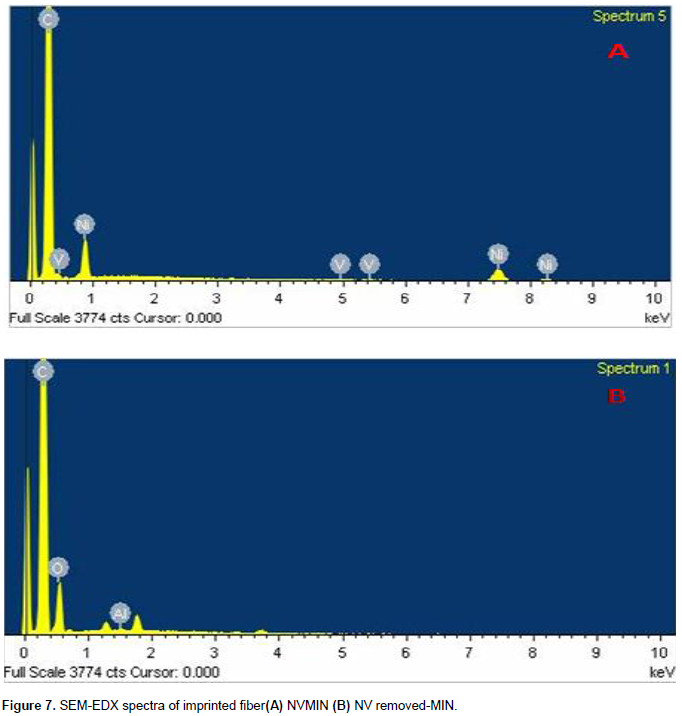
FTIR spectra of both NVMIN and NV removed-MIN are shown in Figure 8. FTIR can be used to qualitatively identify functional groups that are present in fiber structures. Both NTPP and VTPP were composed of central metal atoms surrounded by nitrogen atoms. The NVMIN imprinted fiber spectrum showed absorption bands at 559, 1013, 1200, 1600 and 1671 cm-1 that were attributed to Ni-N, V=O, C–N, conjugated C=N, and C=C systems, respectively, and indicated the success of the imprinting process. The spectrum for the NV removed-MIN showed a distinct characteristic peak at 701 cm-1 which could be attributed to C-H vibration and the peaks of the NTPP and VTPP molecules at 559, 1013 and 1200 cm-1 vanished after excessive washing. The observation spectral absorptions implied that all template molecules had been completely removed.

Solvent effect
There are several variables, such as the type of monomer or the nature of the cross-linker and the choice of solvent that affect the adsorption efficacy in terms of capacity, affinity and selectivity for the target analytes. Acetonitrile, ethyl acetate, dichloromethane and chloroform were selected as dissolvers to optimize extraction solvent by using 50 mg L-1 NTPP standard solution. As shown in Figure 9, the effect of the solvent nature on the adsorption is obvious. NTPP adsorbs strongly in chloroform and dichloromethane because both solvents contained more oxidizing species with chloroform being the best. However, in ethyl acetate the strength decreased and in acetonitrile the adsorption strength is the weakest among the solvents. In addition, the highest extraction percentage achieved in chloroform could be attributed to its low dipole moment (µ = 1.04), compared to other solvents which have higher dipole moments (dichloromethane µ = 1.60, ethyl acetate µ = 1.78, and acetonitrile µ = 3.92).
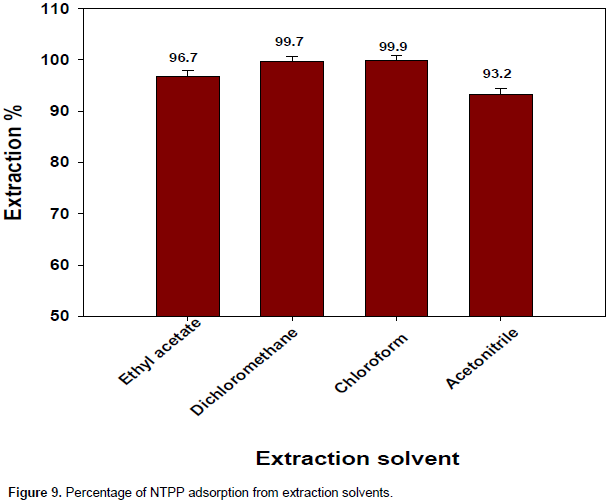
Adsorption of NTPP onto NVMIN
The successful application of imprinted fibers necessitates the availability of materials with appropriate physical properties and selectivity. NTPP binding was studied in an organic environment at a low concentration level. Figure 10 shows that the rebinding capacity was varied from 99.3 to 99.9% at a concentration range from 10 to 50 mg L-1. The result illustrated that the NVMIN showed higher affinity (99% higher) for NTPP than NIN, indicating that the NVMIN contains a lot of specific binding sites.
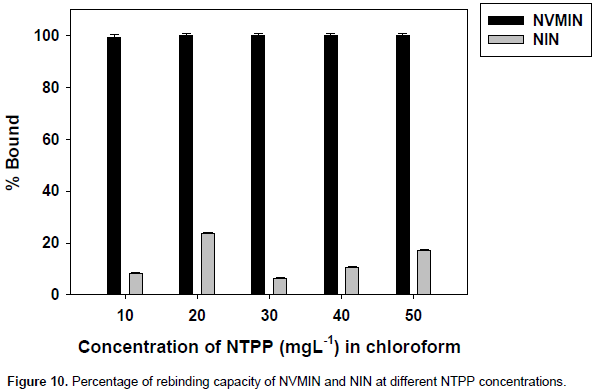
Adsorption selectivity
Competitive adsorption experiments on NVMIN and NIN were conducted in chloroformsolution containing NTPP and VTPP, respectively. All the concentrations were 50 mg L-1. As shown in Figure 11, the adsorption capacities of NTPP and VTPP to the NVMIN were about 33.3 and 33.3 mg g-1, respectively; whereas those to the NIN were about 0.8 and 0.8 mg g-1, respectively. Obviously, the adsorption capacities of NTPP and VTPP on the NVMIN were higher than those on the NIN. The recognition coefficients (α) of NTPP and VTPP were 41.6 and 41.6, respectively, according to Equation (2). It can be demonstrated that NVMIN synthesized for both NTPP and VTPP had the same selectivity specialism for these molecules.
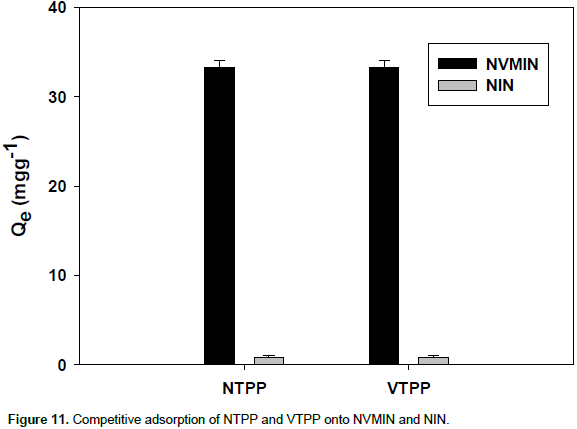
Adsorption thermodynamics
The thermodynamics parameters were calculated using the following equations (Li et al., 2009).

Where R is the universal gas constant (8.314 J mol-1 K-1), T (K) is the absolute temperature and KD is the equilibrium constant (KD = Qe/Ce), where Qe (mgg-1) corresponds to the amount of NTPP adsorbed by NVMIN at adsorption equilibrium and Ce (mg L-1) is the equilibrium concentration of NTPP in the solution. Thus, ∆H° and ∆S° were obtained from the slope and intercept of the line plotted by KD versus 1000/T, respectively. The obtained thermodynamic parameters are listed in Table 3. The negative values of ∆G° indicate the spontaneous nature of adsorption process. When the initial concentration increased from 10.0 to 50.0 mg L-1, the free energy change shifts to high negative value, and suggested that the adsorption was more spontaneous and favourable at higher concentration and temperature, respectively. Moreover, the negative values of enthalpy change ∆H° indicated that the binding of NTPP was exothermic in nature. By adsorption of abundant NTPP onto NVMIN surface, the number of the organic molecules surrounding NTPP molecules decreased and the degree of the freedom of the organic molecules increased. Therefore, the positive values of ∆S° suggested an increase in randomness at the solid-solution interface during the adsorption process.

CONCLUSIONS
The present study has demonstrated the feasibility of preparing novel NVMINs using NTPP and VTPP as the mixed-templates for the recognition and selective removal of a group of metalloporphyrins from organic media. The results indicated that mixed-templates NVMINs exhibited outstanding selectivity and adsorption ability for metalloporphyrin group and the recognition coefficients of NTPP and VTPP were 41.6 and 41.6, respectively.Thus, demonstrated that synthesized NVMIN had the same selectivity specialism for these molecules.
The effects of solvents and their properties on electro-spinnability of the PET/L-PEI solutions and the morphological appearance of the PET/L-PEI fibers were investigated qualitatively by means of a scanning electron microscope (SEM). The complex effect of some solvent properties such as dielectric constant, surface tension and evaporation rate on the electrospinning process and final properties of the electrospun nanofiber mats was demonstrated. The spinnable concentration of PET/L-PEI in the single solvent system was around 20% and solution concentrations higher than 24% favours the formation of nanofibers without beads. Among the three modifying liquids, DCM and PEN helped improve the electrospinnability of the PET/L-PEI solution with PEN being the best modifying liquid, specifically, at all the solvent mixture ratios the nanofibers were continuous and smooth without any beads or droplets in the surface of the electrospun nanofiber.
It was found that adsorption is not only dependent on the cavities but also strongly on the extraction solvent. Thermodynamic parameters indicated that the adsorption process was spontaneous, exothermic with good affinity nature. It can be concluded from the results that imprinting mixtures of templates simultaneously is the best method for producing multi-analyte molecular recognition in complicated samples. It is our strong belief that the knowledge and success of this reactive electrospinning technology to produce cross-linked nanofibers provides a new and versatile opportunity for the processing and application of functional macromolecules.
CONFLICT OF INTERESTS
The authors have not declared any conflict of interests.
ACKNOWLEDGEMENTS
The authors acknowledge the African Network for Analytical Chemists (SEANAC) and Water Research Commission (WRC) South Africa for their financial supports. They would also like to express their gratitude to the Department of Chemistry and Electron Microscopy Unit, Rhodes University, for facilities and Olabisi Onabanjo University,(Nigeria) for granting study leave to the first author.
REFERENCES
|
Alexander C, Anderson HS, Anderson LI, Ansell RJ, Kirsch N, Nicholls IA, O'Mahony J, Whitecombe MJ (2006). Molecular imprinting science and technology: A survey of the literature for the years up to and 2003. J. Mol. Recognit. 19:106-180. |
|
|
Awokoya KN, Moronkola BA, Chigome S, Ondigo DA, Tshentu Z, Torto N (2013). Molecularly imprinted electrospun nanofibers for adsorption of nickel-5,10,15,20-tetraphenylporphine (NTPP) in organic media. J. Polym. Res. 20:148. |
|
|
Bhuvanesh G, Nilesh R, Jons H (2007). Poly (lactic acid) fiber: An overview. Progr. Polym. Sci. 32:455-482. |
|
|
Dechain GP, Gray MR (2010). Chemistry and association of vanadium compounds in heavy oil and bitumen, and implications for their selective removal. Energy Fuels 24:2795-808. |
|
|
Dickert F, Achatz P, Halikias K. (2001). Double molecular imprinting− A new sensor concept for improving selectivity in the detection of polycyclic aromatic hydrocarbons (PAHs) in water. Fresen. J. Anal. Chem. 371:11-15. |
|
|
Li CN (2001). Residue processing. Beijing: China Petrochemical Press. pp. 404-405. |
|
|
Li KQ, Wang XH (2009). Adsorptive removal of Pb(II) by activated carbon prepared from Spartina alterniflora: Equilibrium, kinetics and thermodynamics. Bioresour. Technol. 100:2810-2815. |
|
|
Long FX, Gevert BS (2003). Kinetic parameter estimation and statistical analysis of vanadyl etioporphyrin hydrodemetallization. Comput. Chem. Eng. 27:697-700. |
|
|
Mohammed FA, Saeed A (2006). A review of methods for the demetallization of residual fuel oils. Fuel Process Technol. 87:573-84. |
|
|
Mosbach K (2006). The promise of molecular imprinting. Sci. Am. 295:86-91. |
|
|
Nakamoto Y, Ishimaru T, Endo N, Matsusaki K (2004). Determination of vanadium in heavy oils by atomic absorption spectrometry using a graphite furnace coated with tungsten. Anal. Sci. 20:739-741. |
|
|
Ramstrom O, Mosbach K (1999). Synthesis and catalysis by molecularly imprinted materials. Curr. Opin. Chem. Biol. 3:759-764. |
|
|
Reynolds JG (2004).Removal of nickel and vanadium from heavy crude oils by exchange reactions. Prepr. Symp− Am. Chem. Soc. Div. Fuel Chem. 49:79-80. |
|
|
Schmidt J, Prignitz R, Peschka D, Münch A, Wagner B, Bänsch E, Peukert W (2012). Conductivity in nonpolar media: Experimental and numerical studies on sodium AOT-hexadecane, lecithin-hexadecane and Al(dips)3-hexadecane systems. J. Coll. Interf. Sci. 386:240-251. |
|
|
Schweitz L, Anderson LI, Nilsson S (2002). Molecularly imprinted CEC sorbents: Investigation into polymer preparation and electrolyte composition. Analyst 127:22-28. |
|
|
Shuangcheng W, Jingyi Y, Xinru X (2011). Effect of the cationic starch on removal of Ni and V from crude oils under microwave irradiation. Fuel 90:987-991. |
|
|
Spegel P, Schweitz L, Nilsson S (2003). Selectivity toward multiple predetermined targets in nanoparticles capillary electrochromatography. Anal. Chem. 75:6608-6613. |
|
|
Sreenivasan K (2007). Synthesis and evaluation of multiply template molecularly imprinted polyaniline. J. Mater. Sci. 42:7575-7578. |
|
|
Sreenivasan K, Sivakumar R (1999). Impacting recognition sites in poly (HEMA) for two compounds through molecular imprinting. J. Appl. Polym. Sci. 71:1823-1826. |
|
|
Suedee R, Srichana T, Chuchome T, Kongmark U (2004). Use of molecularly imprinted polymers from a mixture of tetracycline and its degradation products to produce affinity membranes for the removal of tetracyclin from water. J. Chromatogr. 811:191-200. |
|
|
Ware RA, Wei J (1985). Catalytic hydrodemetallation of nickel porphyrin I. Porphyrin structure and reactivity. J. Catal. 93:100-121. |
|
|
Welter K, Salazar E, Balladores Y, Marquez OP, Marquez J, Martinez Y (2009). Electrochemical removal of metals from crude oil samples. Fuel Process Technol. 90:212-221. |
|
|
Xu H, Yu DY, Wang ZX (2001). Progress of research on the chemistry of porphyrins compounds in petroleum. Chem. Res. Appl. 13:347-352. |
|
|
Yang KG, Liu ZB, Mao M, Zhang XH, Zhao CS (2005). Molecularly imprinted polyether sulfone microspheres for the binding and recognition of bisphenol. Anal. Chim. Acta 546:30-36. |
|
|
Zhang D (2002). Expedite the development of the hydrogenation craft and technology of our country. Pet. Ref. Eng. 32:1-6. |
|
Copyright © 2024 Author(s) retain the copyright of this article.
This article is published under the terms of the Creative Commons Attribution License 4.0